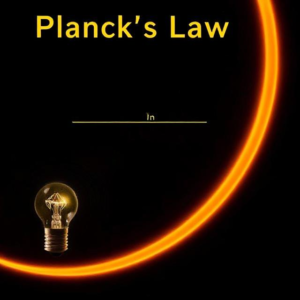Planck’s Law of Radiation: Explained Simply
Planck’s Law is a scientific principle that describes how objects (like the Sun, a lightbulb, or even a hot piece of metal) emit radiation (energy in the form of light or heat). It tells us the amount of energy emitted by an object at a specific temperature and wavelength of light.
To make it simple, Planck’s Law helps us understand how hot objects give off different kinds of light and heat, and how much energy is emitted at different wavelengths.

What is Planck’s Law?
In simple terms, Planck’s Law states that the intensity (or amount) of radiation emitted by an object depends on:
- The temperature of the object.
- The wavelength of the radiation.
Planck’s Law Formula:
Planck’s Law can be written as a formula, but don’t worry—we’ll explain it without getting too technical:
- I(λ, T) = Intensity (amount of radiation) emitted at a particular wavelength λ and temperature T.
- h = Planck’s constant (a very small number that shows up in many physics equations).
- c = Speed of light.
- λ = Wavelength of the radiation.
- k = Boltzmann constant (also a very small number related to temperature).
- T = Temperature of the object.
What Does Planck’s Law Tell Us?
- Hotter objects emit more radiation:
- As the temperature of an object increases, it emits more energy in the form of radiation. For example, a hotter metal will glow brighter than a cooler one.
- Radiation depends on the wavelength:
- Planck’s Law tells us that the intensity of radiation depends on the wavelength of light. Different wavelengths correspond to different colors of light. For example:
- Longer wavelengths (like infrared or red light) are associated with lower-energy radiation.
- Shorter wavelengths (like blue or ultraviolet light) are associated with higher-energy radiation.
- Planck’s Law tells us that the intensity of radiation depends on the wavelength of light. Different wavelengths correspond to different colors of light. For example:
- Peak Emission:
- Planck’s Law also shows that the peak wavelength (the wavelength where the object emits the most radiation) shifts depending on the temperature. This means:
- Hotter objects emit shorter wavelengths (like blue or ultraviolet light).
- Cooler objects emit longer wavelengths (like red or infrared light).
- Planck’s Law also shows that the peak wavelength (the wavelength where the object emits the most radiation) shifts depending on the temperature. This means:
Real-World Example:
Think of the Sun and a lightbulb:
- The Sun is extremely hot (around 5,500°C), and it emits a lot of light in the visible spectrum (which is why it looks bright and white to us). According to Planck’s Law, the Sun’s temperature causes it to emit mostly visible light.
- A lightbulb is much cooler (around 2,700°C), and it emits more infrared radiation (heat) and a bit of red light. Planck’s Law helps explain why we see different kinds of light based on temperature.
Key Insights from Planck’s Law:
- Energy Emission Depends on Temperature: The hotter the object, the more energy it emits, and it tends to emit energy at shorter wavelengths (like visible light or UV light).
- Objects Emit Energy at Different Wavelengths: Based on their temperature, objects emit radiation at different wavelengths. Cooler objects emit more infrared radiation (heat), while hotter objects emit more visible light.
- The Shift in Peak Emission: If you increase the temperature of an object, the wavelength at which it emits the most radiation moves to shorter wavelengths (for example, from red light to blue light).
Planck’s Law in Action:
- The Color of Hot Objects:
- When an object gets hotter, its color changes because of Planck’s Law. For example:
- A red-hot metal is around 500°C, emitting mostly infrared and some red light.
- A white-hot metal (like in a welding torch) is around 1,000°C, emitting more visible light.
- A blue-hot metal is even hotter and emits mostly blue light.
- When an object gets hotter, its color changes because of Planck’s Law. For example:
- Blackbody Radiation:
- A blackbody is an idealized object that absorbs all radiation and emits radiation at all wavelengths. Planck’s Law describes how this perfect emitter of radiation behaves. Most objects in nature are not perfect blackbodies, but they can still be modeled using Planck’s Law for estimating the radiation they emit.
- Temperature and Emission Spectrum:
- Different materials emit radiation differently, and Planck’s Law helps explain why. It shows how temperature and the type of material affect the wavelength and intensity of radiation.
In Simple Terms:
Planck’s Law helps us understand how objects at different temperatures emit radiation (light and heat). Hot objects give off more energy, and the color or type of radiation they emit depends on their temperature. For example, the Sun is hot and gives off a lot of light, while a lightbulb is cooler and gives off more heat.











